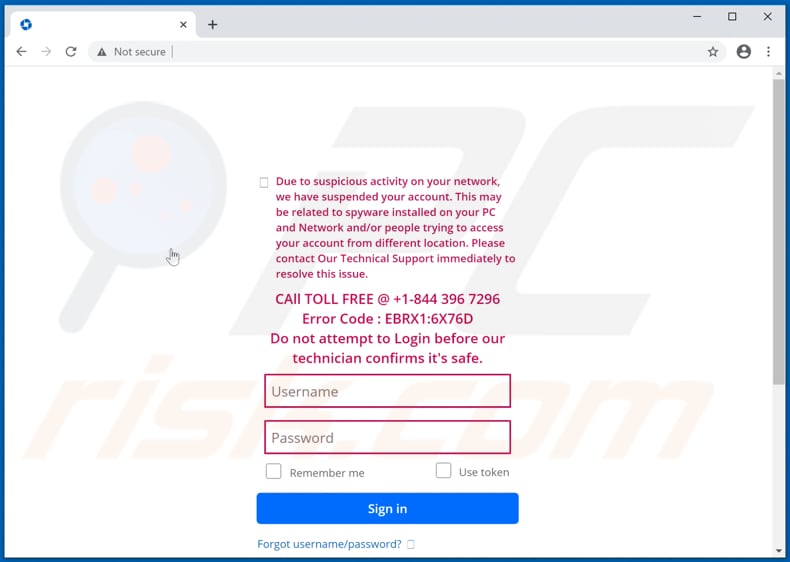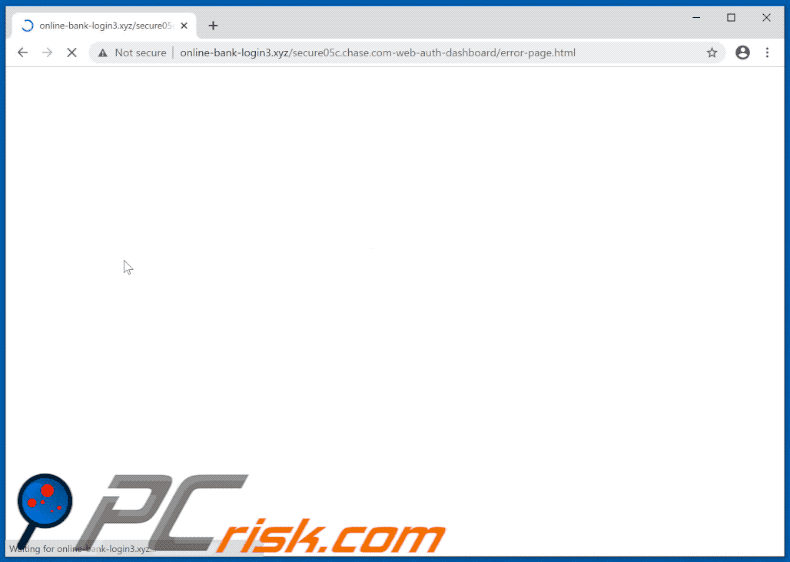Uninstall apps designed to open Error Code : EBRX1:6X76D and similar scams
Phishing/ScamAlso Known As: Error Code : EBRX1:6X76D tech support scam
Get free scan and check if your device is infected.
Remove it nowTo use full-featured product, you have to purchase a license for Combo Cleaner. Seven days free trial available. Combo Cleaner is owned and operated by RCS LT, the parent company of PCRisk.com.
What is "Error Code : EBRX1:6X76D"?
This is a typical technical support scam website, which is designed to trick visitors into calling the provided number and then paying for supposedly legitimate (and unnecessary) remote technical support.
Generally, people do not visit these web pages intentionally - they are opened through other untrusted pages, deceptive advertisements or by installed potentially unwanted applications (PUAs).

As stated in this scam website, the account was suspended due to "some suspicious activity" on the network relating to installed malware and/or attempts to access the account from a different location. To solve the problem, visitors are asked to call the provided number (+1-844 396 7296) immediately.
Also, visitors are warned not to try to log into the account without getting a confirmation that is safe to do so from a technician. Generally, when scammers are contacted (called), they offer a supposedly legitimate technical support service and ask to be paid for it.
In other cases, they ask users to install a Remote Administration Tool (RAT) onto their computers so that they can access and control them remotely. Typically, they use RATs to steal sensitive information (e.g., login credentials, credit card details) or infect computers with malware (e.g., ransomware, Trojans).
Note that technical support scam websites (or other similar pages) can never be trusted and should be ignored. If the website cannot be closed normally, end the browser process in Task Manager. The previously closed session (web page) should not be reopened when running the browser again.
Commonly, technical support scams (and other untrusted web pages) are opened by browsers due to installed PUAs. Note that these apps can be designed to collect browsing data such as IP addresses, entered search queries, addresses of visited pages, geolocations, and even personal, sensitive details.
The developers sell gathered information to third parties (potentially, cyber criminals) or misuse it to generate revenue in other ways. Users might thus become victims of identity theft, experience problems relating to browsing safety, online privacy, etc. Furthermore, PUAs can serve coupons, banners, surveys, coupons and other ads.
These ads often open dubious web pages and, in some cases, can even execute scripts designed to download or even install PUAs.
| Name | Error Code : EBRX1:6X76D tech support scam |
| Threat Type | Phishing, Scam, Social Engineering, Fraud. |
| Fake Claims | Account suspended due to suspicious activity, computer may be infected with spyware, someone has attempted to access the account from a different location. |
| Tech Support Scammer Phone Number | +1-844 396 7296 |
| Related Domain | online-bank-login3[.]xyz |
| Detection Names | Avira (Phishing), Emsisoft (Phishing), ESET-NOD32 (Phishing), Kaspersky (Phishing), Full List Of Detections (VirusTotal). |
| Symptoms | Fake error messages, fake system warnings, pop-up errors, hoax computer scan. |
| Distribution methods | Compromised websites, rogue online pop-up ads, potentially unwanted applications. |
| Damage | Loss of sensitive private information, monetary loss, identity theft, possible malware infections. |
| Malware Removal (Windows) |
To eliminate possible malware infections, scan your computer with legitimate antivirus software. Our security researchers recommend using Combo Cleaner. Download Combo CleanerTo use full-featured product, you have to purchase a license for Combo Cleaner. 7 days free trial available. Combo Cleaner is owned and operated by RCS LT, the parent company of PCRisk.com. |
Some more examples of other similar scam websites are "Error MS-77X1", "Covid19 Warning Alert" and "Your Computer Has Been Locked". Most are used to extort money from unsuspecting visitors by deceiving them into paying for unnecessary technical support (and/or software).
The scammers behind these pages might also try to trick users into installing Remote Administration software allowing them to control computers remotely. Note that users often download/install PUAs, which open these untrusted pages, inadvertently.
How did potentially unwanted applications install on my computer?
PUAs are often downloaded and installed through clicking intrusive advertisements that execute certain scripts, however, they mostly infiltrate during download/installation of other software. I.e., when PUAs are included into the set-ups as 'additional offers'. This distribution method is known as "bundling".
Unwanted apps get permission to be downloaded and/or installed when users fail to check and change "Custom", "Advanced" and other similar settings.
How to avoid installation of potentially unwanted applications
Download all software only from official and trustworthy websites. Third party downloaders, installers, Peer-to-Peer networks (e.g., torrent clients, eMule, etc) and other tools, sources of this kind can be used to distribute potentially unwanted (or even malicious) apps.
Check "Custom", "Advanced" and other similar settings, and decline offers to download or install unwanted applications. Do not click ads that appear on dubious, unofficial web pages, since they can lead to other untrusted websites or even cause download/installation of PUAs.
Remove any suspicious extensions, add-ons and plug-ins that are already installed on the browser. The same applies to programs of this kind that are installed on the computer/operating system. If your computer is already infected with PUAs, we recommend running a scan with Combo Cleaner Antivirus for Windows to automatically eliminate them.
Text presented in "Error Code : EBRX1:6X76D" pop-up:
Due to suspicious activity on your network, we have suspended your account. This may be related to spyware installed on your PC and Network and/or people trying to access your account from different location. Please contact Our Technical Support immediately to resolve this issue.
CAll TOLL FREE @ +1-844 396 7296 Error Code : EBRX1:6X76D Do not attempt to Login before our technician confirms it's safe.
CALL TOLL FREE @ +1-844 396 7296 NOW!
The appearance of "Error Code : EBRX1:6X76D" pop-up scam (GIF):

Instant automatic malware removal:
Manual threat removal might be a lengthy and complicated process that requires advanced IT skills. Combo Cleaner is a professional automatic malware removal tool that is recommended to get rid of malware. Download it by clicking the button below:
DOWNLOAD Combo CleanerBy downloading any software listed on this website you agree to our Privacy Policy and Terms of Use. To use full-featured product, you have to purchase a license for Combo Cleaner. 7 days free trial available. Combo Cleaner is owned and operated by RCS LT, the parent company of PCRisk.com.
Quick menu:
- What is Error Code : EBRX1:6X76D tech support scam?
- How to identify a pop-up scam?
- How do pop-up scams work?
- How to remove fake pop-ups?
- How to prevent fake pop-ups?
- What to do if you fell for a pop-up scam?
How to identify a pop-up scam?
Pop-up windows with various fake messages are a common type of lures cybercriminals use. They collect sensitive personal data, trick Internet users into calling fake tech support numbers, subscribe to useless online services, invest in shady cryptocurrency schemes, etc.
While in the majority of cases these pop-ups don't infect users' devices with malware, they can cause direct monetary loss or could result in identity theft.
Cybercriminals strive to create their rogue pop-up windows to look trustworthy, however, scams typically have the following characteristics:
- Spelling mistakes and non-professional images - Closely inspect the information displayed in a pop-up. Spelling mistakes and unprofessional images could be a sign of a scam.
- Sense of urgency - Countdown timer with a couple of minutes on it, asking you to enter your personal information or subscribe to some online service.
- Statements that you won something - If you haven't participated in a lottery, online competition, etc., and you see a pop-up window stating that you won.
- Computer or mobile device scan - A pop-up window that scans your device and informs of detected issues - is undoubtedly a scam; webpages cannot perform such actions.
- Exclusivity - Pop-up windows stating that only you are given secret access to a financial scheme that can quickly make you rich.
Example of a pop-up scam:

How do pop-up scams work?
Cybercriminals and deceptive marketers usually use various advertising networks, search engine poisoning techniques, and shady websites to generate traffic to their pop-ups. Users land on their online lures after clicking on fake download buttons, using a torrent website, or simply clicking on an Internet search engine result.
Based on users' location and device information, they are presented with a scam pop-up. Lures presented in such pop-ups range from get-rich-quick schemes to fake virus scans.
How to remove fake pop-ups?
In most cases, pop-up scams do not infect users' devices with malware. If you encountered a scam pop-up, simply closing it should be enough. In some cases scam, pop-ups may be hard to close; in such cases - close your Internet browser and restart it.
In extremely rare cases, you might need to reset your Internet browser. For this, use our instructions explaining how to reset Internet browser settings.
How to prevent fake pop-ups?
To prevent seeing pop-up scams, you should visit only reputable websites. Torrent, Crack, free online movie streaming, YouTube video download, and other websites of similar reputation commonly redirect Internet users to pop-up scams.
To minimize the risk of encountering pop-up scams, you should keep your Internet browsers up-to-date and use reputable anti-malware application. For this purpose, we recommend Combo Cleaner Antivirus for Windows.
What to do if you fell for a pop-up scam?
This depends on the type of scam that you fell for. Most commonly, pop-up scams try to trick users into sending money, giving away personal information, or giving access to one's device.
- If you sent money to scammers: You should contact your financial institution and explain that you were scammed. If informed promptly, there's a chance to get your money back.
- If you gave away your personal information: You should change your passwords and enable two-factor authentication in all online services that you use. Visit Federal Trade Commission to report identity theft and get personalized recovery steps.
- If you let scammers connect to your device: You should scan your computer with reputable anti-malware (we recommend Combo Cleaner Antivirus for Windows) - cyber criminals could have planted trojans, keyloggers, and other malware, don't use your computer until removing possible threats.
- Help other Internet users: report Internet scams to Federal Trade Commission.
Share:

Tomas Meskauskas
Expert security researcher, professional malware analyst
I am passionate about computer security and technology. I have an experience of over 10 years working in various companies related to computer technical issue solving and Internet security. I have been working as an author and editor for pcrisk.com since 2010. Follow me on Twitter and LinkedIn to stay informed about the latest online security threats.
PCrisk security portal is brought by a company RCS LT.
Joined forces of security researchers help educate computer users about the latest online security threats. More information about the company RCS LT.
Our malware removal guides are free. However, if you want to support us you can send us a donation.
DonatePCrisk security portal is brought by a company RCS LT.
Joined forces of security researchers help educate computer users about the latest online security threats. More information about the company RCS LT.
Our malware removal guides are free. However, if you want to support us you can send us a donation.
Donate
▼ Show Discussion